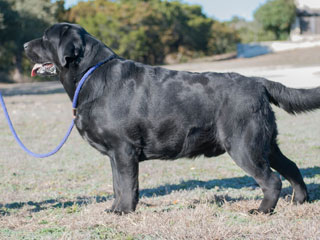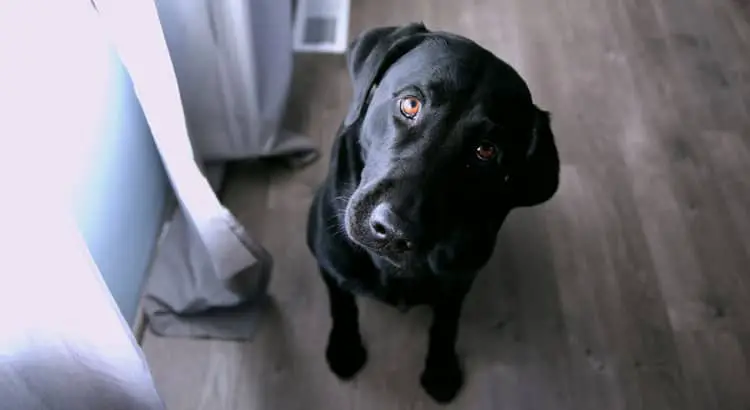You’re worried your dog will feel like he’s confined to a prison cell.
But Labs don’t think that way.
Yes, Labradors can live very well in an apartment. Contrary to much of the advice given on this subject, Labradors are among the best breeds for an apartment. Once acclimated and trained, you’ll find their demeanor and temperament perfectly suited for smaller living spaces.
“How can this be?” you ask.
In this article we’ll cover:
- A Labrador’s space needs
- Exercise needs for your dog’s age
- 7 Tips for raising a Lab in an apartment and keeping him safe while you’re away.
Don’t Labs Need More Space?
People often think that a Labrador’s size makes it unsuited for an apartment or small house. The logic usually goes something like – “But Labs are big dogs, and our apartment is so small.”
This false thinking comes from the misconception that their Labrador will be doing its running and exercising inside the apartment.
However, if you give your Labrador proper and frequent exercise, they’ll be doing most of their running around outside at a local park or along the sidewalk of your neighborhood, not inside your apartment.
Consider this common-sense nugget…
Your Lab’s favorite place to be is right next to you.

This means that whether you have a five hundred- or five thousand-square-foot living space, your best friend’s first inclination will be to stand, sit, or lay as close to you as possible.
Our Black Lab, “Trooper,” demonstrates this principle perfectly.
We make sure our boy gets daily outdoor walks, runs, and play time. But when he’s indoors, he’s our “proximity pooch.”
When I’m working at the computer, he’s never less than four feet from my chair. If I have to migrate to another room, he makes sure I’m given canine escort. When he’s left alone or separated from any of us, he immediately whimpers and shows signs of separation anxiety.
His first response to being apart from the family is not to bask and romp in the “expansive floorspace” of our home. His anxious behavior demonstrates a singular thought – “Where are my humans? I must be near them now!”
So don’t worry about the size of your apartment. Your Lab certainly won’t.
How Much Exercise Do Labs Need?
It should come as no surprise to anyone who has ever observed these bounding bundles of playfulness that Labradors can be high-energy dogs.
The Lab descends from a now extinct breed that was known to work tirelessly during the day and still have enough energy in the evenings to romp with its owners’ children in the evening.
Much like you and me, when Labs don’t get the exercise they need, they become sluggish, melancholy, and restless. They can also build up a fair amount of energy that, if not given a healthy outlet, will result in chewed up furniture and broken valuables.
Giving your furry friend a healthy dose of daily exercise will ensure that their mind stays properly stimulated, their heart and muscles stay healthy, and their weight is kept under control. This will also foster a calm and content demeanor when indoors.
Newborn Puppies
For the first 3 months of their lives, Labs don’t need any kind of regimented exercise plan. Labrador puppies will provide all the physical activity their bodies need through the normal course of play.
3 Months and Up

After 3 months and before fully grown, your dog should receive approximately 5 minutes of exercise per month of age.
This means that a 6-month-old Lab should be getting about a half-hour of walking and/or running every day. Likewise, a 9-month-old Lab should be getting about 45 minutes of daily exercise.
After Fully Grown
From the time your Labrador is fully grown and up to 5-years of age, he should receive around 45-90 minutes of exercise every day. These times will vary depending on age and energy level.
When your dog begins to enter his “elder years” (after 6-7 years of age) his daily exercise requirement will tend to slow down.
So, When is a Lab Fully Grown?
Obviously, this is one of those “it depends” questions.
Labradors mature somewhere between 9 and 18 months. Your Lab will probably reach his full height by 9-10 months. After that, much of his growth will be as his torso and body “fills out.”
Whether your dog is neutered will also affect its growth rate. Neutering is the interruption of your dog’s sex hormone production. These hormones work naturally to arrest a dog’s growth. When a dog’s sex hormones are removed, the dog continues to grow for longer than it would otherwise.
According to official AKC (American Kennel Club) standards, when a purebred Lab reaches full adulthood, a male will weigh between 65-80 lbs. (55 to 70 lbs. for a female). Male purebred Labradors will stand between 22.5 and 24.5 inches tall at the shoulder (21.5 to 23.5 inches for females).
7 Tips for Raising a Lab in an Apartment
Raising a Labrador in an apartment requires responsibility and commitment.
Here are 7 tips for successfully raising your Labrador in an apartment.
 1. Make Sure Pets Are Allowed
1. Make Sure Pets Are Allowed
Don’t set yourself up for a heartbreak. The last thing you would ever want to do is be forced to move or to give up the Lab that you’ve come to love as a part of the family.
So, do your research to ensure that your apartment complex allows pets. Most apartments will charge a deposit for keeping a pet.
You’ll also want to ask if your landlord’s pet policy has any breed or weight restrictions. Many places will not allow dogs that weigh more than 25 pounds.
2. Commit to Daily Time with Your Lab
Labradors are every bit as social as we are and will not thrive in an environment where they are ignored or neglected.
Make sure that you’re willing to set time aside every day for regular potty breaks, leash time, and exercise. If your apartment is on an upper floor, then multiple trips downstairs (probably several times a day) for walks and bathroom breaks and will inevitably be in your future.
3. Acclimate Your Dog to Its Environment
Apartments can be new and scary places for dogs.
They bring strangers, kids, bicycles, and other dogs, all within close proximity to your front door. Many apartment buildings are also susceptible to the noise of street traffic, next-door neighbors, and nearby construction.
Assuming your Lab will naturally be comfortable with all of these new elements would be a mistake. Introduce him to the sights and sounds of apartment life gradually and in a supervised capacity.
4. Devote Yourself to Potty training
Puppies require more supervision than full-grown dogs in the potty training department. Training a puppy requires considerably more trips outside than a trained dog. And if your apartment is on one of the higher floors, this can prove especially challenging.
For the responsible Lab owner, this means getting your daily steps in with multiple trips up and down stairs or frequent rides on the elevator.
Another option to consider is a “pee pad.” This will help train the dog until he can control himself for longer periods between potty trips. Be patient with your pup during this formative time. And understand that accidents will happen.
5. Consider Your Neighbors
Be respectful of the people you say, “Hello” to in the hallway and with whom you share a wall. A dog that is aggressive toward children and strangers will create a miserable living condition for both you and your fellow apartment dwellers. Likewise, constant and excessive barking will not win you any brownie points with your neighbors, either.
It’s important that you invest your time early on to train your Lab not to bark and to be comfortable with other people. Your local vet or pet store should be able to recommend options for behavioral training. Many pet stores even offer weekly classes.
6. Maintain Regular Vet Appointments

It is of the utmost importance that your Lab is current on his vaccinations and parasite preventions – especially when living in community with others.
If your apartment complex is like most, it will have either indoor and/or outdoor shared common areas. This means your dog will inevitably come in contact with other people, children, and dogs.
Maintaining regular veterinarian appointments, and keeping up your dog’s vaccinations and parasite medications will ensure both your dog’s health and the health of your neighbors.
Also, in the rare instance that someone accuses your Lab of biting, you will be relieved to have documented proof of your dog’s vaccinations.
7. Keep Your Lab Safe and Content While You’re Away
Like most Lab owners, you probably have a full-time job. Keeping your Labrador in an apartment while at work takes thoughtfulness and intention, but is entirely manageable.
Wear Them Out Before You Leave
Make sure your dog gets a good dose of exercise before you’re out the door. This will put them in a content and rested state for the time you two are apart.
A Secure and Comfortable Crate
Most Labs do not do well roaming the house by themselves.
Labradors are among the breeds known for their separation anxiety. A size-appropriate crate that is well constructed and comfortable will provide your Lab with a familiar and secure environment during their time alone.
Crate-training your dog as early as possible will help condition them to a daily routine and will help to prevent behavior problems down the road. Keep the crate in a room that is familiar to them, and give them a comfortable bed to lay on inside the crate. Be sure never to leave your Lab alone outside during the day.
Keep Them Occupied and Stimulated
Some chew toys inside the crate will keep them from becoming bored. Be sure to include water and perhaps some familiar blankets.
Phone a friend or Hire a professional
With puppies, it’s best not to leave them crated for more than 4 hours at a time. When dogs are forced to hold their urine or feces for long periods, it can lead to urinary tract infections.

If at all possible, arrange for a friend or family member to check in on them and let them out for a short time during the day. If you have the resources, you can also hire someone to care for them. While most Lab owners can’t afford to put their pet in doggie day-care for the day, paying a dog-walker is much more affordable.
If your budget doesn’t allow for a dog walker, perhaps you and a friend could work out a barter system. Be creative.
In Conclusion
I hope I’ve successfully persuaded you that a Labrador is more than suited for apartment life. If you invest the thought and care to create a loving environment that is safe and structured, your apartment will be a haven of health, joy, and contentment for both you and your Lab.
Did you find this article helpful?
Click on one of the Share Links below to share it with a friend.

